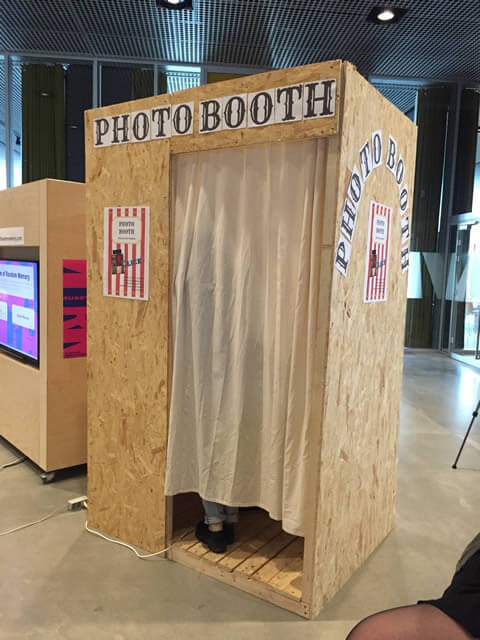Face-off! Platform versus Self: A photobooth experiment
Marie Steensen, Aarhus University, Denmark;Annette Markham, Aarhus University Center for STS; Mette Hegaard, Aarhus University, Centre for STS-studies; Maria Thing Nielsen, Aarhus University, Centre for STS-studies; Lydia Choi, Aarhus University, Centre for STS-studies; Julie Bredholt, Aarhus University, Digital Living Research Commence; Jette Mia Johansen, Aarhus University, Information Studies, Digital Living
Boston 2017: Pedagogy

In this photo booth installation, we encourage conference participants to playfully engage with the sociotechnical relation of self / platform. . We seek to deconstruct and playfully reconstruct possible sensemaking processes involved in negotiating self-categorization. The experiment serves as an interactive way to explore the continual and precarious dynamic of agential relation among elements of socio-technical design. Our underlying goal is to critically question how platforms interact with users to construct identity-for-self and identity-for-others (Jenkins, 2000). This is part of a longer series of exhibitions and interventions coming out of Aarhus University’s Future Making project (Markham, 2017). In these interventions, we explore creative and transgressive approaches to scientific and humanistic methods understanding socio-technical relations and the processes of making future memories and cultural heritage within larger systems of autonomous or self-learning social media infrastructures. Through the photobooth installation/experiment, we resist typical “talk about it” sessions, but still generate reflexive insights on categorization in a digital era, where much of our online identity is pre-categorized by platforms. 2) SETUP Phase 1: Generating photos of 4S participants conference participants through a photobooth. The photobooth will be available for everyone to use during the doing and making sessions, throughout the conference (or as scheduled). Participants take a photo of themselves in the photobooth and are given particular options by the system to either choose from predefined categories or invent creative categories. This simple setup functions as a cultural prompt for participants to investigate the social construction of identity within the politics of platform defaults (van Dijck, 2013). Phase 2: Collecting immediate insights and reflections from 4S participants. We will conduct a series of micro-interviews with the participants when they emerge from the photobooth, to help us think about the experiences of participants and to give participants a chance to reflect on the experience through a few key question prompts from us. References: Foucault, M. (1976) [1980]. The History of Sexuality: The Will to Knowledge, vol. 1. London: Penguin. Giddens, A. (1986). The Constitution of Society: Outline of the Theory of Structuration. UCPress. Jenkins, R. (2000). Categorization: Identity, Social Process and Epistemology. Current Sociology, 48, 7-25. Losh, E. (2015). Feminism Reads Big Data: “Social Physics,” Atomism, and Selfiecity. International Journal of Communication, 9, 1647-59. Manovich, L. (2014). Selfiecity. http://selfiecity.net Markham, A. (2017). Future Making. Blog. http://futuremaking.space/ Van Dijck, J. (2013). The Culture of Connectivity. New York: Oxford University Press.
Published: 01/30/2023
